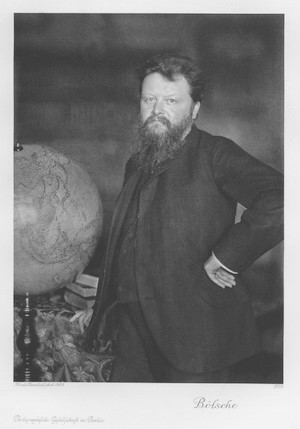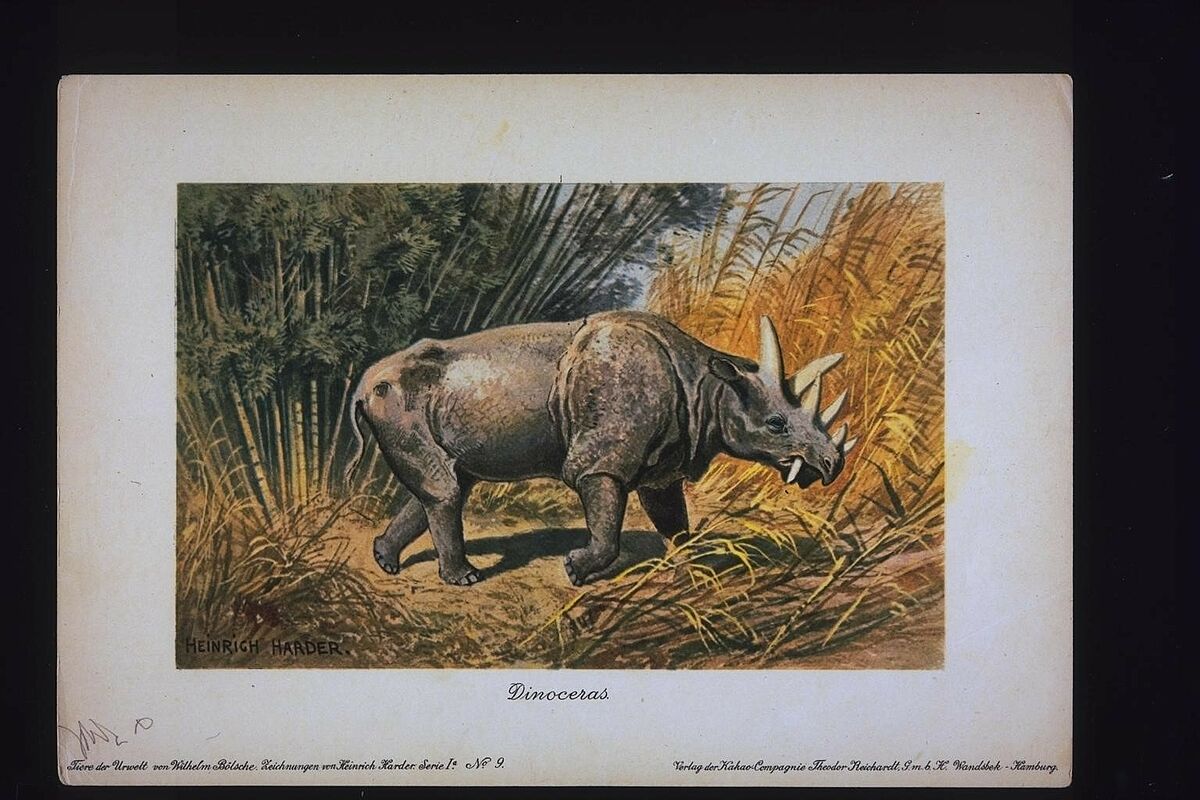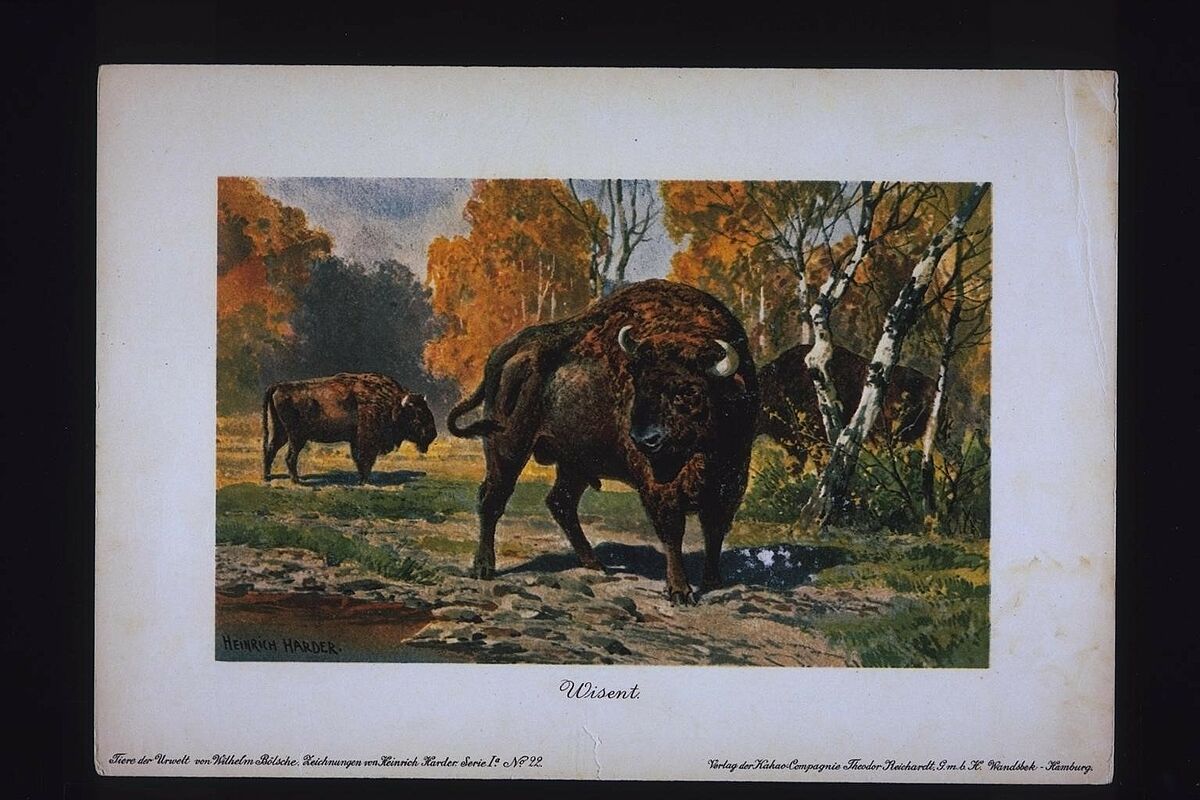'Tiere der Urwelt': Darwinism and Colonialism
by Alexander Bräuer, 03/27/2016.
Summary
Illustrations play an often underestimated part in our construction of primeval times. Today, movies like Jurassic Park, Ice Age or 10,000 BC have fundamentally altered the popular understanding of distant times. In Germany, the early 20th century saw the rise of another popular media combining picturesque illustrations on the front with short informative texts on the back: trading cards. Trading cards were often distributed together with colonial products like chocolate, coffee or tobacco, and promoted not only colonialisms but, at the same time, communicated new scientific achievements to the masses. The trading card series Tiere der Urwelt (“Animals of the prehistoric world”) in particular linked ideas of colonialism and Darwinism with a vision of an American antiquity. The following article shows how such a linkage of different discourses could be created and how trading cards like Tiere der Urwelt thereby became tools in order to justify genocidal policies toward indigenous people in settler colonies.
Born on the 2nd of June 1858 in Putzar, East Lower Pomerania, the painter Heinrich Harder was one of the most influential persons for the creation of a visual culture of the prehistoric period in Germany during the early 20th century. Harder delivered the illustrations for several publications by Wilhelm Bölsche on the primeval times, such as articles in the popular newspaper Die Gartenlaube, children books, and a series of trading cards named Tiere der Urwelt (“animals of the primeval world”, Translation AB). Trading cards usually combined beautiful, instructive, advertising, and exotic or funny illustrations on the front with an explanation on the backside and represented a popular medium to reach the German public. They were widely used for commercial advertisement, political goals, and the promotion of colonialism. The series by Harder and Bölsche showed and explained animals of primeval times in their natural surroundings. These surroundings were placed on specific continents and sometimes contained human beings in interaction with the animals. The following article will analyze how the trading cards Tiere der Urwelt used the semantics of American antiquity to represent a popular Darwinist worldview, which sheds a light on the colonial implications of this process.
Trading Cards in Germany
Starting in the 1860s, Stollwerck, the chocolate manufacturer from Cologne, produced probably the most famous trading cards in Germany. Since then trading cards and colonial products worked hand in hand and popularized the colonial project in the German public. They provided information about colonies and the products they accompanied. Thereby colonialism could be experienced at home and become an integral part of everyday life. The collector’s trading cards Tiere der Urwelt were published by the Theodore Reichardt cacao company in Wandsbek, Hamburg. Tiere der Urwelt consisted of three series of cards (Ia, II and III), each one containing 30 cards. Series Ia and III were illustrated by Heinrich Harder, series II by F. John, and all three were inscribed by Wilhelm Bölsche.

This article will concentrate on series Ia, published ca. between 1902-1916 and consisting of 30 colored illustrations in 19,6 x 27,4 cm. The cards circulated widely and were probably given away as a supplement to cocoa boxes by the Theodore Reichardt cacao company, one of the biggest producers of chocolate on the market. Each card had a chromo-lithographic picture of an animal on the front and a text with further information on the back. All cards of the series could be combined in a collector’s album produced by the company.
The front of the trading cards was dominated by the illustrations of Heinrich Harder, which show the animals in their natural environment. They feature the name of the animal below the illustrations. The paintings by Heinrich Harder are clearly inspired by his earlier illustrations and the well-known work of Charles R. Knight for the American Museum of Natural History in New York. Therefore, the illustrations could build on an already existing visual culture around the depiction of the prehistoric world and popularize them via the wide circulation of trading cards. Furthermore, the illustrations incorporated elements of landscape paintings which Harder studied under Eugen Bracht in Berlin. When the spectator had absorbed the illustration on the front, the back could provide information on the animal circling around diverse topics such as a description of the animals, their position in the evolution, the location of their habitat, selected places of famous findings, fables, mysteries, and scientific disputes over the animals. Seven of the 30 animals are placed on the North American continent.
Darwinism in Tiere der Urwelt
The interplay between illustration and text plays an important role for the promotion of Darwinism in Tiere der Urwelt. It is hardly surprising that Wilhelm Bölsche, one of the most important advocates of Darwinism in the German public discourse,[1] took Darwin’s evolution theory as a model for explaining the extinction of prehistoric species.
In trading card No. 9 he explains that, because of its headgear, the “Dinoceras” (today “Uintatherium”) is inferior in intelligence to the rhinoceros or bull. Heinrich Harder takes the argument up and translates it into the visual representation of the animal. The Dinoceras becomes a stupid looking version of a rhinoceros with a funny headgear. Furthermore, Bölsche explained the extinction of the Dinoceras: „Man wird annehmen dürfen, daß es längere Zeit in einer Art „Asyl“ lebte, einer futterreichen Gegend, in der es an großen Angreifern fehlte, …“ (We can assume that it lived for a long time in an asylum, in an area rich of food where big attackers were missing, Translation AB). For Bölsche “Asyl” or the so-called “Asyltier” becomes a trope to explain the (future) extinction of a number of (prehistoric) animals living especially in areas colonized by humans and later white settlers, like Australia, New Zealand, and North America (see for example trading card 3: “Moa-Vögel”; trading card 22: “Der Wisent”; and trading card 30: “Die Leguatie”). Their extinction is presented as an unavoidable (“unaufhaltsam”) natural result of their own – sometimes even moral – shortcomings. They are described as reckless (“sorglos”), harmless (“harmlos”) and passive (“untätig”).[2] This perspective could easily be integrated into the popular contemporary evolutionary worldview and associated with the vanishing race theory. Around 1900, colonial race theory regarded Native Americans – and other colonized people who were accredited with similar weak physical and moral characteristics like the extinct animals – as a vanishing race. This way, the narrative of the extinction of prehistoric animals provided settler colonialism with an exculpatory argument and the other way around. All merged into one popular master theory of natural competition, struggle and selection of species/races.
The Role of Science in Tiere der Urwelt
Modern science plays an important role in the narrative of Darwin’s evolutionary theory at the nexus between colonialism and the prehistoric world. In some instances, Bölsche refers rather directly to the value of colonies as a place for scientific research where important finds could be made (see trading card 17: “Das Mammut”). However, there are two crucial roles for scientists in the contemporary discourses on prehistoric animals. First, Harder painted two animals together with human hunters (see trading card 1: “Riesengürteltier” & trading card 3: “Moa-Vögel”). Bölsche expands this imagery by referring in several texts to a possible coexistence of human beings and prehistoric animals in some areas. As a proof for the coexistence he mentions again and again stories and myths (“Sagen”; “Legenden” and “dunkle Volkstraditionen”) by the local and indigenous populations, which could reveal further information on the animals. Important here is the role of science as an interpreter and validator of indigenous stories about prehistoric times, which would be completely useless otherwise (see for example trading card 2: “Riesenfaultier” & trading card 4: “Das Einhorn Elasmotherium”). Therefore, western scientific knowledge is presented as superior to indigenous knowledge systems, even though these were able to store information about prehistoric animals over such long periods of time.
The second role of scientists concerns the intervention into the process of natural selection by protecting selected species. Curiously, not all of the species depicted in Tiere der Urwelt were extinct in 1900.
Some like the Wisent (trading card 22: “Der Wisent”) were – although close to extinction – still extant (“ein Tier auf der Grenze von Lebend und Ausgestorben”). Bölsche argues that although humans had destroyed much of the population of those animals, modern man had only recently developed the proper consciousness to protect them and the scientist stands on the forefront of this protection (see for example trading card 30: Die Leguatie). However, a complete revitalization was not possible, since the process of natural selection according to Bölsche couldn’t be stopped. To preserve some species could facilitate the further scientific collection of knowledge and remind humans of their responsibility as the winner of evolution. During the ‘artificial’ preservation these species would inexorably degenerate and ultimately die out. Following Bölsche, science is able to delay the extinction of an animal – i. e. to interfere with the rule of natural selection – but not to alter its ultimate fate in the evolution. Preservation becomes a step of the process of extinction and it did not matter any longer that some of the ‘prehistoric’ animals on the trading cards were still very much alive. For Bölsche ‘primeval world’ (“Urwelt”) is not necessarily a designation of time, but a designation of the capability of survival. Primeval animals might be living in a contemporary world, however, they will be only capable to survive (for a short time) if humans interfere. The logical endpoint of this development was the extinction of the (prehistoric) animals and their display in museums (as described on trading card 22: “Der Wisent”). The proper way to protection was via the establishment of reservations or other areas of protection, one of the driving interests for the foundation of National Parks around 1900. As the interpretation of Darwin’s evolutionary theory, these ideas could be easily transferred to the situation of Native Americans in North America. Although it was thought that they were vanishing, proper protection in selected reservations – which would unavoidably have led to a degeneration of the race – had to be established in order to learn as much as possible from their culture while they were still alive. Here again, contemporary discourses on Native Americans and ideas about ‘prehistoric’ animals were merged with the help of an evolutionary worldview.
The message of Tiere der Urwelt must have been unmistakably clear for the German public at the turn of the 19th into the 20th century: American antiquity witnessed the extinction of prehistoric animals as a result of an evolutionary struggle between different species, just as the world around 1900 experienced a struggle between human races, followed by the extinction of the ‘weaker race’. Scientists, even though some of them commiserated with the extinction of Native Americans, thought they could only record and explain this natural event for the benefit of the superior human races.
NOTES
[1] Sarasin, Philipp. “”Zäsuren biologischen Typs”: der Kampf ums Überleben bei Wilhelm Bölsche, H. G. Wells und Steven Spielberg“. In: Schramm, Helmar & Schwarte, Ludger & Lazardzig, Jan (eds.). Spuren der Avantgarde: Theatrum anatomicum: frühe Neuzeit und Modern im Kulturvergleich. Berlin: Walter de Gruyter, 2011, pp. 443-459, p. 447.
[2] All quotations are taken from trading card 30, where Bölsche explains his definition of an “Asyltier” by referring to the Leguatia gigantean, an extinct species on Reunion. Today, the existence of the Leguatia gigantean is very much disputed. Islands or other forms of spatial isolation are seen by Bölsche as a crucial factor for the evolution of an “Asyltier.”
ILLUSTRATIONS
Figure 1: Wilhelm Bölsche. Source: https://en.wikipedia.org/wiki/Wilhelm_B%C3%B6lsche; accessed 03/23/2016.
Figure 2: front of trading card No. 9. Source: Tiere der Urwelt: Rekonstruktionen nach verschiedenen wissenschaftlichen Vorlagen. Wandsbek-Hamburg: Verl. der Kakao Compagnie Theodor Reichhardt, ca. 1900. diglib.bis.uni-oldenburg.de/retrodig/buch.php; accessed 03/27/2016.
Figure 3: front of “22) Der Wisent (Bison bonasus oder europaeus): ein Tier auf der Grenze von Lebend und Ausgestorben.“ Source: Tiere der Urwelt: Rekonstruktionen nach verschiedenen wissenschaftlichen Vorlagen. Wandsbek-Hamburg: Verl. der Kakao Compagnie Theodor Reichhardt, ca. 1900. diglib.bis.uni-oldenburg.de/retrodig/buch.php; accessed 03/27/2016.


